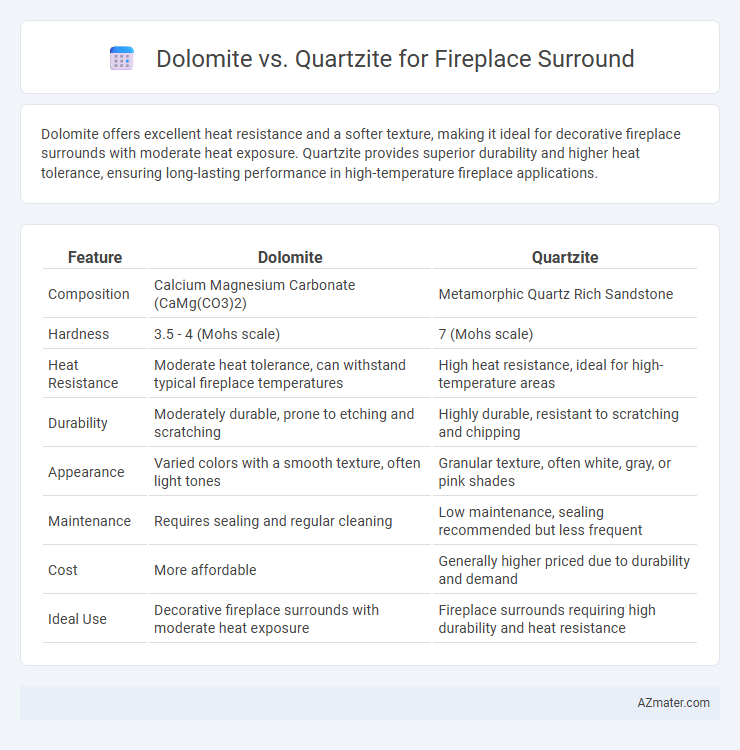Dolomite offers excellent heat resistance and a softer texture, making it ideal for decorative fireplace surrounds with moderate heat exposure. Quartzite provides superior durability and higher heat tolerance, ensuring long-lasting performance in high-temperature fireplace applications.
Table of Comparison
| Feature | Dolomite | Quartzite |
|---|---|---|
| Composition | Calcium Magnesium Carbonate (CaMg(CO3)2) | Metamorphic Quartz Rich Sandstone |
| Hardness | 3.5 - 4 (Mohs scale) | 7 (Mohs scale) |
| Heat Resistance | Moderate heat tolerance, can withstand typical fireplace temperatures | High heat resistance, ideal for high-temperature areas |
| Durability | Moderately durable, prone to etching and scratching | Highly durable, resistant to scratching and chipping |
| Appearance | Varied colors with a smooth texture, often light tones | Granular texture, often white, gray, or pink shades |
| Maintenance | Requires sealing and regular cleaning | Low maintenance, sealing recommended but less frequent |
| Cost | More affordable | Generally higher priced due to durability and demand |
| Ideal Use | Decorative fireplace surrounds with moderate heat exposure | Fireplace surrounds requiring high durability and heat resistance |
Introduction to Fireplace Surround Materials
Dolomite and quartzite are popular natural stone options for fireplace surrounds due to their durability and aesthetic appeal. Dolomite features a fine-grained texture with a subtle, muted color palette that enhances classic and contemporary designs, while quartzite offers exceptional hardness and a striking range of colors and patterns, making it resistant to heat and wear. Choosing between dolomite and quartzite depends on desired style, maintenance preferences, and the specific thermal properties suited for high-temperature environments like fireplace surrounds.
What is Dolomite?
Dolomite is a sedimentary carbonate rock composed mainly of the mineral dolomite, calcium magnesium carbonate, prized for its durability and resistance to heat, making it an excellent choice for fireplace surrounds. It offers a unique crystalline texture and often features subtle, earthy hues that provide a natural and elegant aesthetic in interior design. Compared to quartzite, dolomite typically has a slightly softer surface but maintains strong structural integrity and excellent thermal properties suited for fireplace applications.
What is Quartzite?
Quartzite is a natural metamorphic rock formed from sandstone subjected to intense heat and pressure, resulting in an extremely hard and durable surface ideal for fireplace surrounds. Its resistance to heat, scratches, and staining makes quartzite a superior choice compared to dolomite, which is a softer sedimentary rock composed primarily of calcium magnesium carbonate. Quartzite's dense crystalline structure offers both aesthetic appeal with its natural veining and practical longevity in high-heat environments.
Aesthetic Differences: Dolomite vs Quartzite
Dolomite offers a subtle, creamy texture with soft veining that creates a warm, elegant atmosphere perfect for traditional fireplace surrounds. Quartzite features a harder, more crystalline appearance with bold, dramatic patterns and a glossy finish, ideal for modern or contemporary designs. The distinct mineral content in quartzite results in brighter, more varied colors compared to the muted tones and smoother texture of dolomite, influencing the overall aesthetic impact in living spaces.
Durability and Heat Resistance Comparison
Dolomite offers excellent heat resistance with its crystalline structure, making it suitable for fireplace surrounds exposed to high temperatures. Quartzite provides superior durability due to its natural hardness and resistance to abrasion, ensuring long-lasting performance in both heat exposure and daily wear. Both stones are durable choices, but quartzite tends to outperform dolomite in maintaining structural integrity under continuous heat stress.
Maintenance and Cleaning Requirements
Dolomite requires minimal maintenance due to its natural resistance to scratches and stains, making it an ideal choice for fireplace surrounds that endure regular use. Quartzite, while highly durable, demands more frequent sealing to prevent staining and maintain its polished surface over time. Regular cleaning with non-abrasive, pH-neutral cleaners is essential for both materials to preserve their appearance and longevity in fireplace applications.
Cost Considerations
Dolomite offers a cost-effective option for fireplace surrounds, typically priced lower than quartzite due to its relative abundance and ease of quarrying. Quartzite, being a naturally harder and more durable stone, commands a higher price point reflecting its premium aesthetic and longevity. Homeowners should weigh initial expense against long-term durability and maintenance when choosing between dolomite and quartzite for fireplace projects.
Installation Process and Challenges
Dolomite and quartzite both offer durable options for fireplace surrounds, but their installation processes vary due to material properties. Dolomite is softer and easier to cut, reducing labor time and minimizing tool wear, while quartzite's extreme hardness demands specialized diamond blades and skilled installers to avoid chipping. Challenges with quartzite include managing its brittleness during handling and ensuring precise alignment to prevent fractures, whereas dolomite's porosity requires sealing to protect against heat and staining.
Pros and Cons Summary: Dolomite vs Quartzite
Dolomite offers excellent durability and heat resistance, making it a practical choice for fireplace surrounds, with a natural, subtle color palette that complements various interior styles. Quartzite provides superior hardness and scratch resistance, along with vibrant, striking patterns that add a luxurious aesthetic, but it can be more expensive and requires professional installation to handle its dense composition. Both materials resist heat well, though dolomite is generally easier to maintain, while quartzite's strength ensures long-term wear with minimal risk of damage.
Choosing the Best Material for Your Fireplace Surround
Dolomite offers durability and heat resistance, making it a practical choice for fireplace surrounds, with its fine grain and subtle veining providing a sophisticated aesthetic. Quartzite excels in hardness and scratch resistance, featuring natural quartz crystals that enhance its sparkle and toughness, ideal for high-traffic or heavy-use fireplace areas. Selecting the best material depends on balancing heat tolerance, maintenance needs, and desired visual appeal to ensure long-lasting performance and style.

Infographic: Dolomite vs Quartzite for Fireplace Surround
 azmater.com
azmater.com